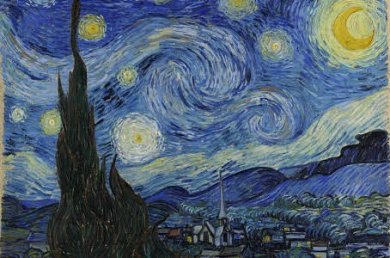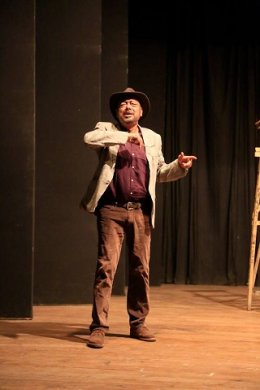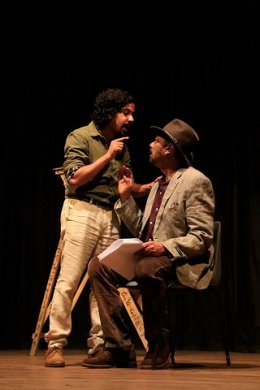
|   |

|   |
 e-mail: ukb7@rediffmail.com Portrait of a tortured artist Photos: Abhishek Ghosh June 17, 2018  Starry Night by Vincent van Gogh Vincent van Gogh (1853 -1890), a Dutch Post-Impressionist painter, was among the most famous and influential figures in the history of Western art. In just over a decade, he created about 2,100 artworks, including around 860 oil paintings, most of them in the last two years of his life. They include landscapes, still lifes, portraits and self-portraits, and were characterized by bold colours and dramatic, impulsive and expressive brushwork that contributed to the foundations of modern art. His suicide at barely 37 followed years of mental illness and poverty. Van Gogh suffered from psychotic disorders and delusions and though he worried about his mental stability, he often neglected his physical health, did not eat properly and drank heavily. His friendship with the celebrity Impressionist painter Paul Gauguin ended after a confrontation with a razor, when in a rage he severed part of his own left ear. His depression continued and in July 1890, Van Gogh shot himself in the chest with a revolver. He died from his injuries two days later. Though unsuccessful during his lifetime -- being considered a madman and a failure - Van Gogh became famous after his suicide, and exists in the public imagination as the quintessential misunderstood genius: the artist "where discourses on madness and creativity converge." His reputation began to grow in the early 20th century and he attained widespread critical, commercial and popular success over the ensuing decades, remembered today as an important but tragic painter, whose troubled personality typifies the romantic ideal of the cast-away artist. Taray Taray presented on May 29 by Swapna Sandhani - on their 26th anniversary - was a wonderfully vivid filigree of the Van Gogh saga encapsulated at multiple levels. At one level, it is young Ritwik (essayed very well by Riddhi Sen) suffering from hallucinations that he is the torch-bearer of the past legacy of Van Gogh. Lovingly looked after by wife Sharmila (Surangama), he is undergoing treatment by a psychiatrist Ruksana (donned most competently by Reshmi Sen). In recapitulating Holland and France as the artistic milieus of the 19th century, Van Gogh is seen as the suffering, struggling painter - remarkably brought alive by the brooding acting style of the thespian Anjan Dutta - with whom Ritwik's life is entwined as his younger brother, Theo, who has a love-hate relationship with sibling Vincent, while supporting him financially all through his years of gnawing penury.
That the two kept up a life-long friendship -- most of what is known of Vincent's thoughts and theories of art, are recorded in the hundreds of letters that they exchanged from 1872 until 1890 -- becomes beautifully apparent in the play's dialogue in their imaginary past, besides Theo being seen as an art dealer and providing Vincent with emotional support and access to influential men. Apart from the tumultuous psychic disorder of Ritwik at the present -- and of Van Gogh 150 years back - the play also shows a severely disturbed Ruksana who, while treating Ritwik, needs medical succor for her own mental turmoil. In a script crafted and directed by the thespian Kaushik Sen based on a recent novella, Tarabhara Akasher Neeche by Srijata, the three tumultuous mental cataclysms - of Ritwik, Van Gogh and Ruksana - are lyrically and simultaneously interfaced in the backdrop of Van Gogh's gorgeous tapestry of paintings and, most of all, in the invoking of his soul-stirring painting Starry Night as one of the most recognized pieces of art in today's world. It is absolutely everywhere too, and remains a magnificent testament as to how its beauty is timeless and universal. Van Gogh painted Starry Night in 1889 during his stay at the asylum of Saint Paul de Mausole near Saint Rémy de Provence. If one notices the brush strokes, they swirl for the sky, each dab of color rolling with the clouds around the stars and the moon. On the cypress tree, they bend with the curve of the branches. The whole effect is ethereal and dreamlike, with the hills easily rolling down into the little village below. In contrast, the habitat goes up and down, done with rigid lines that interrupt the flow of the brush strokes. One of the biggest points of interest about this painting is that it came entirely from Van Gogh's imagination. None of the scenery matches the area surrounding Saint Paul or the view from his window. As a man who religiously paints what he sees, Van Gogh deviates remarkably and breaks out from his normal oeuvre. 

In the end, the canvas of Starry Night descending from above and Ritwik's ambling dialogue letting him physically mingle with the canvas was a directorial masterstroke, no less dwarfed by the live recital on a guitar -- by Neel Dutta, the play's music director - of the stirringly sad song Vincent by Don McLean, written as a tribute to Van Gogh: Starry Starry night Paint your palette blue and grey... Look out on a summer's day With eyes that know the Darkness in my soul. Shadows on the hills Sketch the trees and the daffodils... Catch the breeze and the winter chills...  Dr. Utpal K Banerjee is a scholar-commentator on performing arts over last four decades. He has authored 23 books on Indian art and culture, and 10 on Tagore studies. He served IGNCA as National Project Director, was a Tagore Research Scholar and is recipient of Padma Shri. Post your comments Please provide your name and email id when you use the Anonymous profile in the blog to post a comment. All appropriate comments posted with name & email id in the blog will also be featured in the site. |